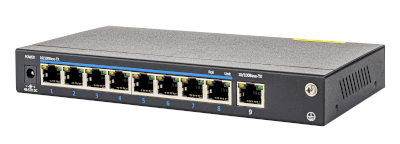What Is a Power Over Ethernet (PoE) Extender?

Power over Ethernet (PoE) is a technology that simultaneously provides data communication and power supply through an ethernet cable.
This enables both data communication and power supply to be realized with a single cable, instead of the conventional method of separating data communication and power supply, thereby simplifying infrastructure facilities and reducing costs. PoE is used in a wide variety of devices, including surveillance cameras, wireless LAN access points, and VoIP telephones.
Uses of Power Over Ethernet (PoE) Extenders
A typical use for power over ethernet (PoE) extender is in IP-based surveillance camera systems. Since power and data communication are carried over a single cable, it does not matter if there is no power supply at the location where the camera is installed.
This makes it easy to extend the range of surveillance and contributes to enhanced security. Other applications include the following
1. Wireless Network Equipment
Wireless LAN access points are another important use case for PoE. When providing wireless connectivity throughout a building, PoE allows for flexible device placement. Access points can be installed in optimal locations, without being limited by where power supply is required.
2. VoIP Telephony
The same cable is used for telephone and data transmission, making it easy to install and move the phone. In addition, phones can be used even during power outages, making them an excellent means of communication during emergencies.
3. IoT Devices
PoE is used to power IoT devices, especially sensors and actuators used in smart buildings and smart homes. This allows power supply and data communication over a single cable, greatly simplifying installation and management.
4. Network Switch
Using a PoE-enabled network switch increases the number of devices that can be powered through the switch. This makes cable management easier and enables more efficient network construction.
Principle of Power Over Ethernet (PoE) Extenders
Ethernet cables are typically bundles of eight copper wires, which are responsible for data transmission and power supply.
In this case, there are two modes of supplying power in PoE: Alternative A and Alternative B.
1. Alternative A
In Alternative A, data communication and power are provided using the same pair of cables (1,2 pair or 3,6 pairs). This is also referred to as “end span”.
2. Alternative B
Alternative B uses cables with different pairs for power supply and data communication (4,5 pairs and 7,8 pairs are used for power supply). This is also called the “midspan” or “injector” method.
3. PSE and PD
There are two main components in a PoE system: PSE (Power Sourcing Equipment) and PD (Powered Device). PSE is the device that provides power (such as a network switch or injector) and PD is the device that receives power (such as IP cameras, wireless LAN access points, etc.).
PSE detects whether a PoE-enabled device is connected and provides the appropriate power. This provides safe protection against non-PoE devices being accidentally connected. It also can accurately measure the amount of power required by the PD and supply it without over- or under-delivery.
Types of Power Over Ethernet (POE) Extenders
There are several different standards for power over ethernet (PoE) extenders, each supporting different power levels; the differences between PoE, PoE+, and PoE++ are as follows:
1. PoE (IEEE 802.3af)
This is the first PoE standard and can provide up to 15.4 watts of power. It is suitable for low-power devices such as IP cameras, VoIP phones, and some wireless access points.
2. PoE+ (IEEE 802.3at)
This standard is an enhanced version of PoE with the ability to provide up to 30 watts of power. This makes it suitable for high-power devices, such as panoramic IP cameras, and high-performance wireless access points like Wi-Fi 6.
3. PoE++ (IEEE 802.3bt)
This standard has been further enhanced and can provide up to 60 watts (Type 3) or 99 watts (Type 4) of power. This allows for the most power-hungry devices that need to be powered over power over ethernet (POE) extender. Examples include digital signage, high-performance Wi-Fi access points, and some laptops.